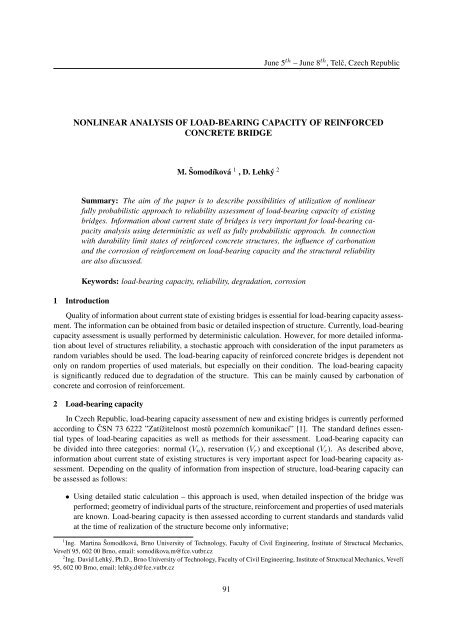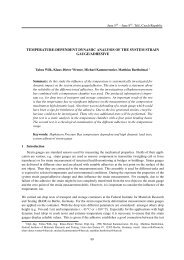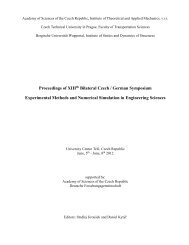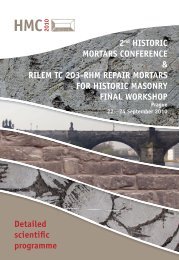nonlinear analysis of load-bearing capacity of reinforced concrete ...
nonlinear analysis of load-bearing capacity of reinforced concrete ...
nonlinear analysis of load-bearing capacity of reinforced concrete ...
You also want an ePaper? Increase the reach of your titles
YUMPU automatically turns print PDFs into web optimized ePapers that Google loves.
June 5 th – June 8 th , Telč, Czech Republic<br />
NONLINEAR ANALYSIS OF LOAD-BEARING CAPACITY OF REINFORCED<br />
CONCRETE BRIDGE<br />
M. Šomodíková 1 , D. Lehký 2<br />
Summary: The aim <strong>of</strong> the paper is to describe possibilities <strong>of</strong> utilization <strong>of</strong> <strong>nonlinear</strong><br />
fully probabilistic approach to reliability assessment <strong>of</strong> <strong>load</strong>-<strong>bearing</strong> <strong>capacity</strong> <strong>of</strong> existing<br />
bridges. Information about current state <strong>of</strong> bridges is very important for <strong>load</strong>-<strong>bearing</strong> <strong>capacity</strong><br />
<strong>analysis</strong> using deterministic as well as fully probabilistic approach. In connection<br />
with durability limit states <strong>of</strong> <strong>reinforced</strong> <strong>concrete</strong> structures, the influence <strong>of</strong> carbonation<br />
and the corrosion <strong>of</strong> reinforcement on <strong>load</strong>-<strong>bearing</strong> <strong>capacity</strong> and the structural reliability<br />
are also discussed.<br />
1 Introduction<br />
Keywords: <strong>load</strong>-<strong>bearing</strong> <strong>capacity</strong>, reliability, degradation, corrosion<br />
Quality <strong>of</strong> information about current state <strong>of</strong> existing bridges is essential for <strong>load</strong>-<strong>bearing</strong> <strong>capacity</strong> assessment.<br />
The information can be obtained from basic or detailed inspection <strong>of</strong> structure. Currently, <strong>load</strong>-<strong>bearing</strong><br />
<strong>capacity</strong> assessment is usually performed by deterministic calculation. However, for more detailed information<br />
about level <strong>of</strong> structures reliability, a stochastic approach with consideration <strong>of</strong> the input parameters as<br />
random variables should be used. The <strong>load</strong>-<strong>bearing</strong> <strong>capacity</strong> <strong>of</strong> <strong>reinforced</strong> <strong>concrete</strong> bridges is dependent not<br />
only on random properties <strong>of</strong> used materials, but especially on their condition. The <strong>load</strong>-<strong>bearing</strong> <strong>capacity</strong><br />
is significantly reduced due to degradation <strong>of</strong> the structure. This can be mainly caused by carbonation <strong>of</strong><br />
<strong>concrete</strong> and corrosion <strong>of</strong> reinforcement.<br />
2 Load-<strong>bearing</strong> <strong>capacity</strong><br />
In Czech Republic, <strong>load</strong>-<strong>bearing</strong> <strong>capacity</strong> assessment <strong>of</strong> new and existing bridges is currently performed<br />
according to ČSN 73 6222 ”Zatížitelnost mostů pozemních komunikací” [1]. The standard defines essential<br />
types <strong>of</strong> <strong>load</strong>-<strong>bearing</strong> capacities as well as methods for their assessment. Load-<strong>bearing</strong> <strong>capacity</strong> can<br />
be divided into three categories: normal (V n ), reservation (V r ) and exceptional (V e ). As described above,<br />
information about current state <strong>of</strong> existing structures is very important aspect for <strong>load</strong>-<strong>bearing</strong> <strong>capacity</strong> assessment.<br />
Depending on the quality <strong>of</strong> information from inspection <strong>of</strong> structure, <strong>load</strong>-<strong>bearing</strong> <strong>capacity</strong> can<br />
be assessed as follows:<br />
• Using detailed static calculation – this approach is used, when detailed inspection <strong>of</strong> the bridge was<br />
performed; geometry <strong>of</strong> individual parts <strong>of</strong> the structure, reinforcement and properties <strong>of</strong> used materials<br />
are known. Load-<strong>bearing</strong> <strong>capacity</strong> is then assessed according to current standards and standards valid<br />
at the time <strong>of</strong> realization <strong>of</strong> the structure become only informative;<br />
1 Ing. Martina Šomodíková, Brno University <strong>of</strong> Technology, Faculty <strong>of</strong> Civil Engineering, Institute <strong>of</strong> Structucal Mechanics,<br />
Veveří 95, 602 00 Brno, email: somodikova.m@fce.vutbr.cz<br />
2 Ing. David Lehký, Ph.D., Brno University <strong>of</strong> Technology, Faculty <strong>of</strong> Civil Engineering, Institute <strong>of</strong> Structucal Mechanics, Veveří<br />
95, 602 00 Brno, email: lehky.d@fce.vutbr.cz<br />
91
XIII th Bilateral Czech/German Symposium<br />
• Using combined static calculation – in the case that only geometric parameters <strong>of</strong> structure are known,<br />
combined static calculation is used. According to standards valid at the time <strong>of</strong> realization <strong>of</strong> the structure,<br />
probable reinforcement is designed and <strong>load</strong>-<strong>bearing</strong> <strong>capacity</strong> is assessed with using <strong>of</strong> current<br />
standards;<br />
• Using specific regulations.<br />
3 Deterministic and stochastic <strong>analysis</strong>, degradation<br />
Currently, deterministic <strong>analysis</strong> is performed for assessment <strong>of</strong> <strong>load</strong>-<strong>bearing</strong> <strong>capacity</strong> <strong>of</strong> most bridges.<br />
Variability <strong>of</strong> input parameters is incorporated to the calculation using safety factors. Although information<br />
values <strong>of</strong> individual <strong>load</strong>-<strong>bearing</strong> capacities is obtained, this method do not indicate actual reliability <strong>of</strong> the<br />
structure. For this reason fully probabilistic approach can be used as an alternative for reliability assessment.<br />
The level <strong>of</strong> structural reliability can be quantified by the failure probability p f or reliability index β.<br />
Important difference between stochastic and deterministic <strong>analysis</strong> <strong>of</strong> <strong>load</strong>-<strong>bearing</strong> <strong>capacity</strong> is definition<br />
<strong>of</strong> input parameters (material properties, location <strong>of</strong> reinforcement, etc.). Stochastic approach considers them<br />
as random variables based on the mathematical model <strong>of</strong> probability distributions. These can be obtained<br />
for example from recommendations <strong>of</strong> Joint Committee on Structural Safety (see JCSS Probabilistic Model<br />
Code [2]). Load-<strong>bearing</strong> <strong>capacity</strong> is then assessed with respect to target reliability level.<br />
Very important aspect for <strong>load</strong>-<strong>bearing</strong> <strong>capacity</strong> assessment using deterministic as well as fully probabilistic<br />
approach is the current state <strong>of</strong> structures. Increasing age <strong>of</strong> structure leads to degradation <strong>of</strong> used<br />
materials hence <strong>load</strong>-<strong>bearing</strong> <strong>capacity</strong> and reliability <strong>of</strong> structures become significantly reduced. Degradation<br />
and loss <strong>of</strong> durability have a significant role for planning reconstruction or demolition <strong>of</strong> structures,<br />
thus they have economical consequences. It is therefore important to develop methods for controlling other<br />
types <strong>of</strong> limit states (in addition to traditional ultimate limit state and serviceability state). In the case <strong>of</strong><br />
<strong>reinforced</strong> <strong>concrete</strong> structures the depassivation <strong>of</strong> reinforcing steel can be included as the limit state. This<br />
phenomenon is caused by carbonation <strong>of</strong> surrounding <strong>concrete</strong>. Protective (passivation) layer on the surface<br />
<strong>of</strong> reinforcement is disrupted and corrosion <strong>of</strong> reinforcement is initiated.<br />
4 Analyzed structure<br />
Analyzed structure was the arch bridge over the Morava river near Veselí nad Moravou. The bridge was<br />
built in 1940 (see Fig. 1). Detailed inspection <strong>of</strong> the bridge was carried out so that the detailed static calculation<br />
was used for <strong>load</strong>-<strong>bearing</strong> <strong>capacity</strong> assessment. The geometry <strong>of</strong> individual parts <strong>of</strong> the structure as well<br />
as type and position <strong>of</strong> reinforcement was obtained by the inspection (classic cut probes and radiographic<br />
inspection was used for reinforcement detection).<br />
The numerical model <strong>of</strong> the structure was created using ATENA 2D s<strong>of</strong>tware [3] (see Fig. 2), which was<br />
developed especially for 2-dimensional and 3-dimensional <strong>nonlinear</strong> <strong>analysis</strong> <strong>of</strong> <strong>concrete</strong> and <strong>reinforced</strong> <strong>concrete</strong><br />
structures using finite element method (FEM). Stochastic reliability <strong>analysis</strong> was then performed using<br />
FReET s<strong>of</strong>tware [4]. Because <strong>nonlinear</strong> FEM <strong>analysis</strong> was time-consuming only 32 simulations <strong>of</strong> Latin<br />
Hypercube Sampling method were performed to calculate random response <strong>of</strong> analyzed bridge. Reliability<br />
index according to Cornell [5] was determinated as the main parameter <strong>of</strong> reliability. Comparison <strong>of</strong> obtained<br />
response and defined <strong>load</strong> was used for individual <strong>load</strong>-<strong>bearing</strong> <strong>capacity</strong> assessment (see Tab. 1) with respect<br />
to target value <strong>of</strong> reliability index β = 3.8, which is defined in standards.<br />
Sensitivity <strong>analysis</strong> and parametric study <strong>of</strong> influence <strong>of</strong> decreasing amount <strong>of</strong> reinforcement due to<br />
corrosion on <strong>load</strong>-<strong>bearing</strong> <strong>capacity</strong> was also performed. Time dependent area <strong>of</strong> reinforcement was modeled<br />
using mathematical models <strong>of</strong> corrosion and <strong>concrete</strong> carbonation (see [6]). Dependence <strong>of</strong> reliability index<br />
β on values <strong>of</strong> normal <strong>load</strong>-<strong>bearing</strong> <strong>capacity</strong> V n in time is shown in Fig. 3. Decrease <strong>of</strong> <strong>load</strong>-<strong>bearing</strong> <strong>capacity</strong><br />
with respect to degradation <strong>of</strong> used materials is obvious.<br />
92
June 5 th – June 8 th , Telč, Czech Republic<br />
Figure 1: View on the analyzed bridge in the direction from Veselí nad Moravou toward Bzenec<br />
Figure 2: Numerical model in ATENA s<strong>of</strong>tware<br />
5 Conclusion<br />
The aim <strong>of</strong> this paper was to describe utilization <strong>of</strong> stochastic approach for <strong>load</strong>-<strong>bearing</strong> <strong>capacity</strong> assessment<br />
<strong>of</strong> bridges. This is usually assessed using deterministic approach without detailed consideration<br />
<strong>of</strong> variability <strong>of</strong> input parameters. Depending on the quality <strong>of</strong> information from inspection <strong>of</strong> structure the<br />
detailed static calculation was performed for individual <strong>load</strong>-<strong>bearing</strong> capacities assessment <strong>of</strong> the arch bridge<br />
over the Morava river. Fully probabilistic approach with consideration <strong>of</strong> input values as random variables<br />
was used. The efficacy <strong>of</strong> stochastic <strong>analysis</strong> was proved and detailed information about level <strong>of</strong> structure<br />
reliability was obtained. With respect to the age <strong>of</strong> existing bridges, the significance <strong>of</strong> degradation <strong>of</strong> used<br />
materials on the value <strong>of</strong> normal <strong>load</strong>-<strong>bearing</strong> <strong>capacity</strong> was also discussed and the influence <strong>of</strong> decreasing<br />
amount <strong>of</strong> reinforcement due to corrosion on normal <strong>load</strong>-<strong>bearing</strong> <strong>capacity</strong> was shown.<br />
Table 1: Computed values <strong>of</strong> individual <strong>load</strong>-<strong>bearing</strong> capacities and corresponding safety indices<br />
Load-<strong>bearing</strong> <strong>capacity</strong> Computed Value Safety index<br />
Normal (V n ) V n = 34 tons β = 3.821<br />
Reservation (V r ) V r = 120 tons β = 3.832<br />
Exceptional (V e ) V e = 183 tons β = 3.806<br />
93
XIII th Bilateral Czech/German Symposium<br />
Figure 3: Normal <strong>load</strong>-<strong>bearing</strong> <strong>capacity</strong> with respect <strong>of</strong> reinforcement corrosion<br />
6 Acknowledgment<br />
This contribution was financially supported by Research project No.<br />
Agency <strong>of</strong> Czech Republic (TACR).<br />
TA01011019 <strong>of</strong> Technological<br />
References<br />
[1] Úřad pro technickou normalizaci, metrologii a státní zkušebnictví. ČSN 73 6222 ”Zatížitelnost mostů<br />
pozemních komunikací. Praha (2009), http://www.normy.biz/.<br />
[2] Joint Committee on Structural Safety. Probabilistic Model Code, Part 3: Material Properties, (2000),<br />
http://www.jcss.byg.dtu.dk.<br />
[3] Červenka, V., Jendele, L. & Červenka, J. ATENA Program documentation, Part 1: Theory, Červenka<br />
Conslting, Prague (2010), http://www.cervenka.cz.<br />
[4] Novák, D., Vořechovský, M., Rusina, R., et al. FReET Program Documentation, Part 2: FReET M/A<br />
User Manual, Červenka Consulting, Prague (2005), http://www.freet.cz.<br />
[5] Teplý, B. & Novák, D. Spolehlivost stavebních konstrukcí: teorie, numerické metody, navrhování, s<strong>of</strong>tware:<br />
skriptum FAST VUT, Učební texty vysokých škol (Vysoké učení technické v Brně. Stavební<br />
fakulta), CERM, Brno (2004)<br />
[6] Teplý, B., Chromá, M., Vořechovská, D., et al. FReET-D Deterioration Module Program Documentation,<br />
Part 1: Theory, Červenka Consulting, Prague (2006), http://www.freet.cz.<br />
94








